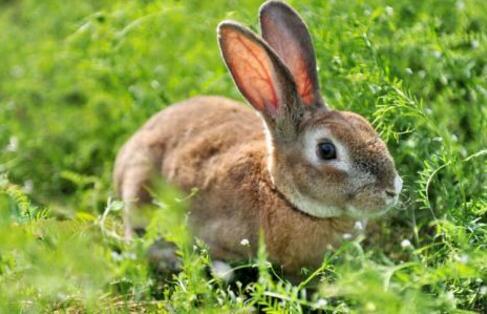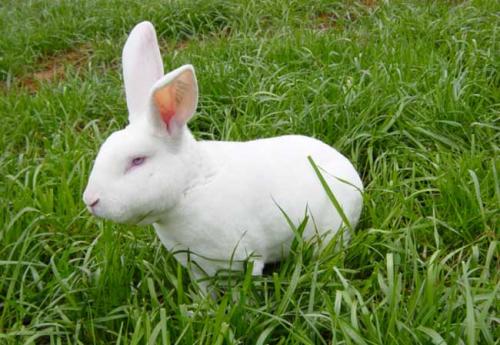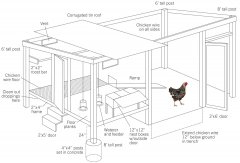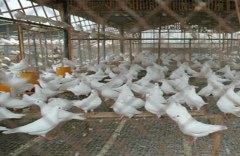What should we pay attention to in raising rabbits? Introduction to the breeding techniques and methods of rabbits
Do you know how to raise rabbits? What aspects should be paid attention to when breeding? How to raise a good rabbit? let's have a look.
Rabbit feeding method
1. It's quiet during the day and good to eat at night.
The living habits of rabbits are similar to those of mice. Lying quietly in the cage during the day, very active at night, and a large number of food intake, it is observed that night food intake accounts for more than 70% of the whole day. Under certain conditions, the meat rabbit is easy to get sleepy or sleep, when the feeling decreases or even disappears. For example, put the rabbit lying on its side or four feet up in a "U" position, and then gently touch the hair with the hands, or touch the temple, the meat rabbit will go to sleep within a minute or two.

2. Timid and afraid
The rabbit is a timid animal, which is panicked by sudden noise, strangers and strange animals, such as cats and dogs. In feeding and management, the sound of rabbit panic should be avoided as far as possible, and strangers, cats and dogs should be prohibited from entering the rabbit house.
Anti-inflammatory, hot and humid, like dry environment
The sweat glands of rabbits are underdeveloped, which mainly rely on breathing to dissipate heat, so long-term exposure to high temperature (more than 35 ℃) humid environment will cause a large number of deaths. The experimental results show that the ideal ambient temperature of adult rabbits is 14 ℃ and the temperature in nests of newborn rabbits is 30 ℃. Drying and cleaning are very beneficial to the health of rabbits. The rabbit is also very hygienic, often using front claws to "wash his face", eating, defecating, urinating and spitting. When the rabbit's anus, mouth and nose are not clear, it shows that there is a disease. We should find out the cause as soon as possible and treat the disease as soon as possible.
3. Timing and quantification
Feed should have a certain number of times, time and quantity, develop eating habits, do not suffer from hunger or overeating, so as to avoid digestive tract diseases.
4. Pay attention to hygiene, anti-corrosion and anti-mildew
Sweep the rabbit cage every day, remove the rabbit dung every day, choose the feeding equipment, change the mat grass frequently, disinfect regularly, keep the rabbit house clean and dry, pay attention to the feed quality, do not feed mildew, rotten and toxic feed, drinking water should be clean.

5. If you don't fit in, you can live alone.
Under natural conditions, rabbits all make holes and live alone. We only get together during the mating season. Both male and female rabbits and homosexual rabbits often fight together, causing trauma, such as biting off ears or testicles. Therefore, rabbits are suitable to be reared in a single cage.
6. Easy to eat
The rabbit's front teeth are permanent teeth and often grow. If the soft material is often fed, the rabbit will naturally gnaw on things such as wooden cages to maintain proper tooth length. Therefore, some branches should be put into the rabbit cage. When making the rabbit cage, there are no edges and corners as far as possible, so that the rabbit can not bite, so as to prolong the service life of the rabbit cage.
Feed diversification, reasonable collocation should be more beans, Gramineae, Compositae plants, mainly green feed, supplement about one or two concentrate feed every day. According to the nutritional ingredients, learn from each other to meet the needs of hare growth and development of a variety of nutrients, do not feed a single, at the same time to prepare overwintering materials, can grow ryegrass, radish and other green feed.
7. Group management, strengthen sports
They are divided into groups according to age, sex and mode of production, and when conditions permit, the hare is often given sports to maintain its wildness.
Feeding and management of young rabbits
The young rabbits from birth to weaning are characterized by incomplete body development and rapid growth, poor regulation, weak adaptability and low resistance.
According to the characteristics of its growth and development, feeding and management can be divided into two stages, namely, the sleeping period and the eye-opening stage. In addition to taking effective measures to make the rabbits eat enough milk, the sleeping rabbits should do a good job of preventing cold and keeping warm, repelling mosquitoes, killing rats, preventing disease, preventing asphyxiation and so on, as well as cleaning inside and outside the box. Feeding during the eye-opening period focuses on feeding and weaning. Feed a small amount of nutritious, digestible and palatable feed, mixed with a small amount of minerals and antibiotics, 5-6 times a day, a small number of meals, gradually increase until weaning. The focus of the management is to separate the mother and cub at the age of 15 days and breastfeed every 12 hours. Often change the mat grass, and wash or replace the nest box.
After each meal, the female rabbit is taken to the playground for proper exercise. Check your health regularly
Hare
Rabbits feed on weeds, leaves and other plants, and there are a wide range of artificial feed sources, such as various forage, green vegetables, straw and so on. Generally, they are fed with green feed and succulent feed for breakfast and lunch, and green feed and a small amount of pellet feed at night.
Many people hunt rabbits for food, and some people take a fancy to the business opportunities of rabbits. Breeding some rabbits can buy them at a relatively good price, so there are more and more hare farmers in recent years. Rabbits will not have the same high feed conversion rate as purebred rabbits, so a lot of problems should be paid attention to in breeding.
First, the environment of the hare requires the hare to rest in a very wide range of places, usually without digging holes. But in order to avoid predators, potholes, grass, stone gaps or cracks are often used for rest. When raising in captivity, attention should be paid to creating a similar environment, and the site should be broad, hygienic and dry, so as to prevent the occurrence of infectious diseases.
2. the activity law of the hare the hare is mainly active at night, especially at dusk or dawn. As a result of life-long life on the ground, when encounter natural enemies, the hare try to hide, motionless. Coupled with its timidity, so breeding should try to prevent harassment and keep the environment quiet. Drinking water and forage should be provided during the day (preferably in the afternoon) for nighttime diet.
Third, the hare's feeding habit hare take grass as the main food, in the cold winter, especially when the snow is covered, such as lack of food, will gnaw bark, twigs and grass roots. In addition, the hare has the habit of eating soft dung, which is a normal digestive function, do not think that eating dung is pica. In order to supplement the lack of feeding, you can put an appropriate amount of grass into the rabbit's circle or house every day, and put some straw in winter, such as bean straw, corn straw and so on.
Can also put some corn, bran and other concentrate, water is more indispensable. Usually put some salt on the board for the hare to eat, which can increase its appetite. 4. The reproductive technology of hare after the hare is sexually mature, it begins to mate when the temperature is suitable.
The north produces 3-4 nests per year, while the south produces 6-8 nests per year. Because of the abundant forage grass from May to October, the survival rate of young rabbits born in spring is higher. When the hare is in estrus, it chases, shakes its tail and enuises. The female rabbit is in estrus for many times, and the male rabbit fights with each other. After mating, the gestation period is 30-40 days. The young rabbits matured sexually in the second year. During the mating period and artificial reproduction, rabbits can be put into the herd according to the proportion of 1 male and 4 females to allow them to mate freely. Human had better not intervene, so the conception rate is relatively high.
After domestication, artificial auxiliary breeding can be carried out. Fifth, the disease prevention and control of hare because the hare is timid, it is difficult to catch, and it is often easy to cause casualties, so it is very difficult to inject vaccine. Oxytetracycline can be added to the feed according to the amount of 0.1 grams per day, stop for 3 days for a week, and then for 3 days, which can play the role of anti-inflammation and promoting growth without disease.
Dysentery can also be added to the feed once a week to prevent diarrhea and coccidiosis.
- Prev

Design of low-cost greenhouse chicken house construction of rural household chicken house
Building a basic chicken coop for a small group of birds is a solid weekend project, preparing for a firm do-it-yourself with basic carpentry skills, while a more sophisticated chicken coop can take weeks (and require advanced carpentry skills). The Internet is full of
- Next

The method of raising pigeons: the most important skill of raising pigeons is the choice of young pigeons.
To raise pigeons, the most important thing for us is the choice of young pigeons, otherwise the raised pigeons are easy to get sick, or there are other problems, then for young pigeons, how do we choose? If you keep it regardless of the pros and cons, it will not only waste energy and material resources, but also guide
Related
- On the eggshell is a badge full of pride. British Poultry Egg Market and Consumer observation
- British study: 72% of Britons are willing to buy native eggs raised by insects
- Guidelines for friendly egg production revised the increase of space in chicken sheds can not be forced to change feathers and lay eggs.
- Risk of delay in customs clearance Australia suspends lobster exports to China
- Pig semen-the Vector of virus Transmission (4)
- Pig semen-the Vector of virus Transmission (3)
- Five common causes of difficult control of classical swine fever in clinic and their countermeasures
- Foot-and-mouth disease is the most effective way to prevent it!
- PED is the number one killer of piglets and has to be guarded against in autumn and winter.
- What is "yellow fat pig"? Have you ever heard the pig collector talk about "yellow fat pig"?

